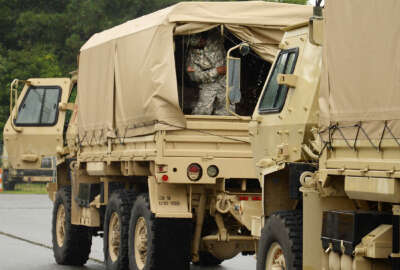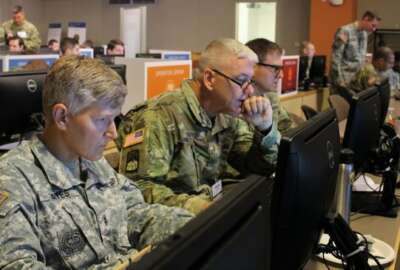 Exclusive
Exclusive National Guard officers waiting more than half a year for promotions
National Guard officers are facing longer wait times for their promotions from the Pentagon.
Officers in the National Guard are getting frustrated with the Defense Department over tardy promotions.
A survey by The National Guard Association of the United States (NGAUS) found some officers were waiting more than six months for their promotions to receive federal recognition.
That also means guardsmen are being paid at their previous rank’s level while doing the work expected in their new rank.
“There’s a back pay issue, where you don’t get your next rank’s pay until you are recognized in that position. You’re serving in a grade that’s higher. You’re serving in that next position, but you’re not getting that time in grade,” J.C. Cardinale, legislative affairs manager at NGAUS told Federal News Radio. “What it really comes down to is a retention issue for us. You’re creating this deep frustration in the Guard.”
NGAUS found that 49 percent of the more than 3,100 guardsmen they polled in the most recent FedRec survey said more than 196 days passed between state recognition and federal recognition of a promotion. Thirty-seven percent waited between 196 days and 120 days and only 14 percent were promoted in less than 120 days.
“This process is 110 percent ridiculous,” one respondent commented, according to a press release by NGAUS.
The Guard promotion process is fairly complicated. It involves states recognizing guardsmen for promotion and then aggregating those promotions into a scroll. That scroll is sent to the Pentagon for verification to quality check the guardsmen’s work and then they are approved.
“We’ve heard stories in the Guard [of waiting times] of 400 days, 500 days once the Pentagon receives it. Active duty is not that long,” Cardinale said.
The military as a whole has been struggling with retention rates while trying to maintain an all-volunteer force.
Cardinale said in the Guard retention is always a big deal.
“It’s something we always strive for. With the economy getting better and the constant operational tempo we are sending guardsmen around the world more often. It’s important we keep an eye on retention and make sure we are not unduly burdening these soldiers,” Cardinale said.
NGAUS hopes the issue can be solved internally through DoD.
“I think the big push is on the awareness front and really this is going to come down to a leadership issue at the Pentagon where they just need to realize that their process needs to be fixed. Whether it needs to be digitized or they need to take some of the steps out of the process,” Cardinale said.
The promotion issue comes as the Guard is putting more demand on some of its troops.
In 2016, Stryker brigades were required to take on more training.
“We don’t have nearly as many of those [units] as we do our infantry brigades, and as you look at requirements around the world, they are units that have to maintain higher levels of readiness,” Army National Guard Director Lt. Gen. Timothy Kadavy said last summer. “The other thing that makes it more complicated is the logistics in supporting large armored and Stryker formations. Logistics in terms of fuels and ammunition and just the large numbers of soldiers in those formations, nearly 4,000, and getting them all on the field at the same time fighting together, maneuvering together.”
The armored brigades, which hold Abrams tanks, and the Stryker brigades now work on a four-year training plan. Members train 39 days in year one, 48.5 days in year two, 60 days in year three and 51 days in year four. That’s compared to 39 days a year of training for other units.
Read more of the DoD Personnel Notebook.
Copyright © 2025 Federal News Network. All rights reserved. This website is not intended for users located within the European Economic Area.
Scott Maucione is a defense reporter for Federal News Network and reports on human capital, workforce and the Defense Department at-large.
Follow @smaucioneWFED





